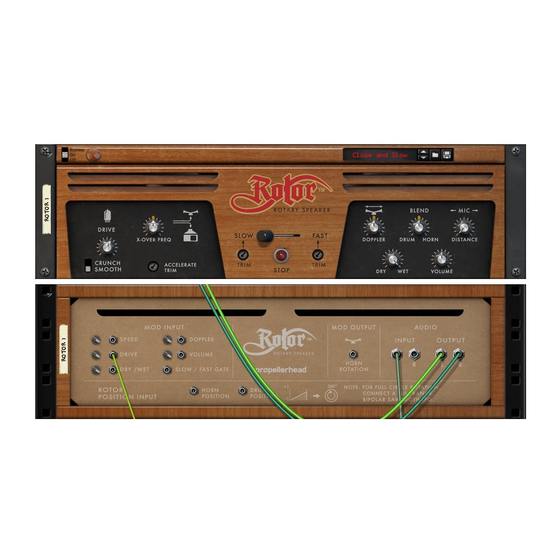Table of Contents
Advertisement
Quick Links
Advertisement
Table of Contents

Summary of Contents for Propellerhead ROTOR
- Page 1 ROTOR OPERATION MANUAL...
- Page 2 The information in this document is subject to change without notice and does not represent a commitment on the part of Propellerhead Software AB. The software described herein is subject to a License Agreement and may not be copied to any other media expect as specifically allowed in the License Agreement. No part of this publication may be copied, reproduced or otherwise transmitted or recorded, for any purpose, without prior written permission by Propellerhead Software AB.
- Page 3 Rotor - Rotary Speaker...
- Page 4 (tremolo). The rotation can also be stopped so that the drum and horn are completely still. All classic features are faithfully mimicked in Rotor, and we have also added a number of additional functions so you can tweak your sounds further.
- Page 5 The default (12 o’clock) setting simulates the acceleration/deceleration times of the classic Leslie 122 rotary speaker. Slow/Fast/Stop Switch between Slow and Fast rotor speeds with the speed switch. Set the Slow speed with the Slow Trim pot. The default (12 o’clock) setting simulates the Slow speed of the classic Leslie 122 rotary speaker.
- Page 6 Top view of the cabinet and microphone placements At low values (close distances) the stereo rotation effect of the horn will be very prominent and at high values (long distances) the stereo effect will be more subtle. ROTOR - ROTARY SPEAKER...
- Page 7 Remember that CV connections are not stored in the Rotor patch! Mod Input These control voltage (CV) inputs (with associated trim pots) can modulate following parameters in Rotor: • Speed Here, you can patch a bipolar CV signal which modulates the Slow and Fast parameters in combination. A positive CV input signal makes both the Slow and Fast parameters go even faster and a negative CV input signal makes them go slower.
-
Page 8: Audio Input
Control assignment tip When you are using Rotor as an effect to process instrument devices, you might want to control the Slow/Fast/Stop functions in Rotor from your MIDI Master Keyboard: 1. Select “Edit Remote Override Mapping…” from the context menu of the Slow/Fast switch on Rotor.


Need help?
Do you have a question about the ROTOR and is the answer not in the manual?
Questions and answers